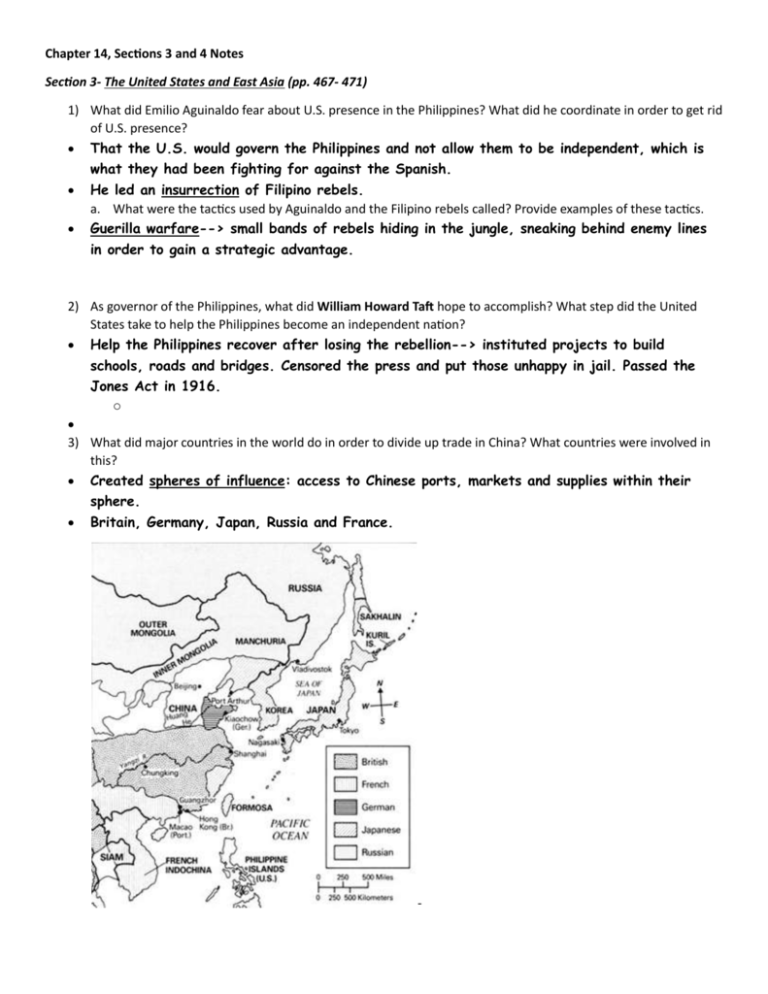Chapter 14, Sections 3 and 4 Notes Section 3
advertisement

Chapter 14, Sections 3 and 4 Notes Section 3- The United States and East Asia (pp. 467- 471) 1) What did Emilio Aguinaldo fear about U.S. presence in the Philippines? What did he coordinate in order to get rid of U.S. presence? That the U.S. would govern the Philippines and not allow them to be independent, which is what they had been fighting for against the Spanish. He led an insurrection of Filipino rebels. a. What were the tactics used by Aguinaldo and the Filipino rebels called? Provide examples of these tactics. Guerilla warfare--> small bands of rebels hiding in the jungle, sneaking behind enemy lines in order to gain a strategic advantage. 2) As governor of the Philippines, what did William Howard Taft hope to accomplish? What step did the United States take to help the Philippines become an independent nation? Help the Philippines recover after losing the rebellion--> instituted projects to build schools, roads and bridges. Censored the press and put those unhappy in jail. Passed the Jones Act in 1916. o 3) What did major countries in the world do in order to divide up trade in China? What countries were involved in this? Created spheres of influence: access to Chinese ports, markets and supplies within their sphere. Britain, Germany, Japan, Russia and France. - 4) Since the United States were not involved in trade with China, what did John Hay propose? What would this policy become known as after the Boxer Rebellion? A policy in which everyone would have shared access to resources. Became known as the 'Open Door Policy'. a. What countries were involved in the Boxer Rebellion? Why was it called this? Japan and China--> named after a Chinese secret society that promoted martial arts. 5) Conflicts rose between Russia and Japan and led to the Russo-Japanese War. For his role in negotiating the peace, Roosevelt won a Nobel Peace Prize. a. What prejudicial actions did Californians take towards Asian-Americans? How did Theodore Roosevelt respond? Banned Chinese, Japanese and Korean children from attending public school. Roosevelt brokered a 'Gentleman's Agreement' with Japan which pledged the end to the school segregation and Japan would limit emigration of its people to the U.S. b. What were the dual purposes behind the sailing of the Great White Fleet around the world? a. Promote 'good will' around the world. b. Demonstrated that the United States was an increased military power within the world. Section 4- The United States in Latin America (pp. 472-479) 1) What actions did the U.S. government take in Puerto Rico in the wake of the Spanish-American War? What actions led to the implementation of rights for Puerto Ricans? Puerto Rico was under direct military rule following the Spanish-American war in 1898. In 1900, Congress passed the Foraker Act which established a civil government in Puerto Rico. President could appoint a governor and part of the legislature. Puerto Ricans could appoint the remainder. Insular cases--> series of Supreme Court cases that established civil rights for Puerto Rican citizens. 2) How did the Platt Amendment solidify the influence of the United States in Cuban affairs? It established Cuba as a protectorate. Restricted the rights of Cubans Stipulated that: o Cuba cannot sign any treaties with other countries without U.S. consent. o U.S. may intervene in Cuban affairs in order to preserve Cuba. 3. What have historians called Roosevelt’s foreign policy towards Latin America? 'big stick diplomacy'--> comes from the saying "speak softly and carry a big stick and you will go far" 4. Explain the events that led to the construction of the Panama Canal. When was construction completed and what did it achieve? French company abandons claims to the building of the Panama Canal. U.S. gov buys rights for $40 million. Colombia was in control of Panama at the time, did not want to give up the land for the U.S.' price. o Roosevelt sent warships to support Panamanian rebels in their fight for independence. Panama gains independence, allows U.S. to build Canal. Completed in 1914--> cut 8,000 miles off of shipping from Atlantic to Pacific. 5. Once again, Venezuela was the site of European interference in the Western Hemisphere. What did Roosevelt do to solidify U.S. superiority in the region? How did Latin Americans feel about this? Pass the Roosevelt Corollary: U.S. would assume role as police power in cases involving chronic wrongdoing (from an economic standpoint). 6. What was Taft’s foreign policy known as? Explain what was meant by this term. "dollar diplomacy": substitution of dollars for bullets in the effort to control Latin American policy. 7. When Woodrow Wilson takes over as president, he prefers "moral diplomacy" to “dollar diplomacy.” How did Wilson’s actions in Latin America (especially Mexico) contradict this idea? Promotion of human rights instead of simply conquering a nation. Wilson used American military to intervene in Mexico's battle for control--> Carranza gov. versus Huerta gov. o Francisco "Pancho" Villa was the leader of the Huerta contingency. Villa invades New Mexico, Wilson responds by sending John Pershing and 10,000 troops as a 'punitive mission' to Mexico.











